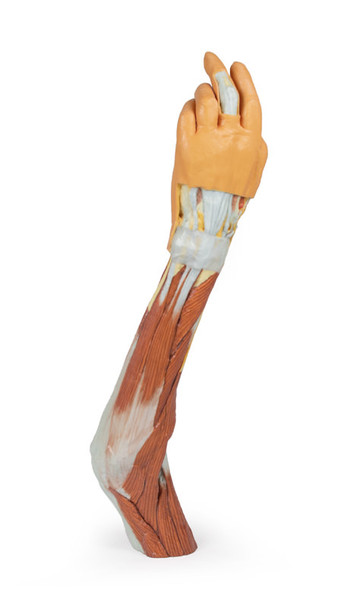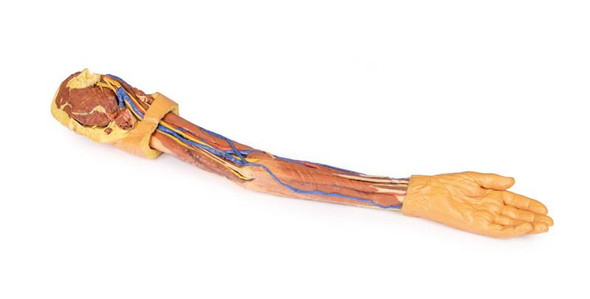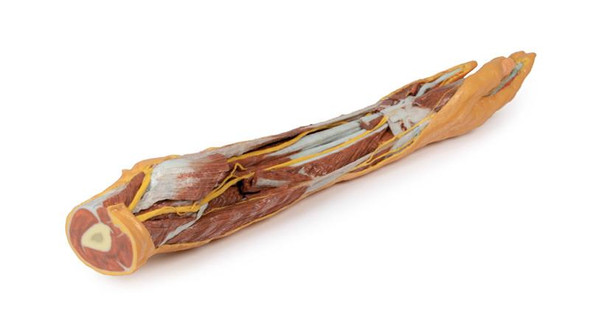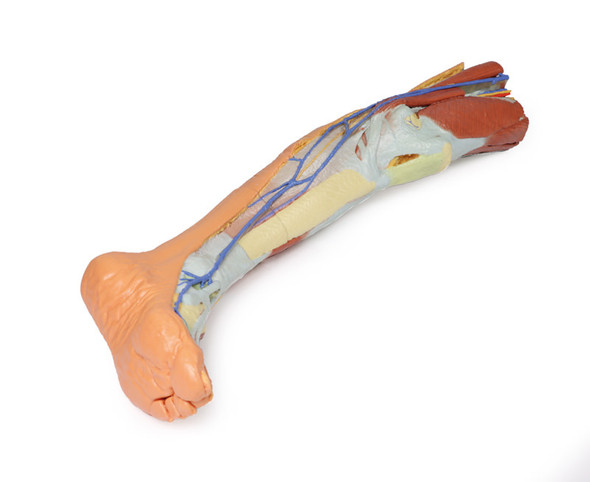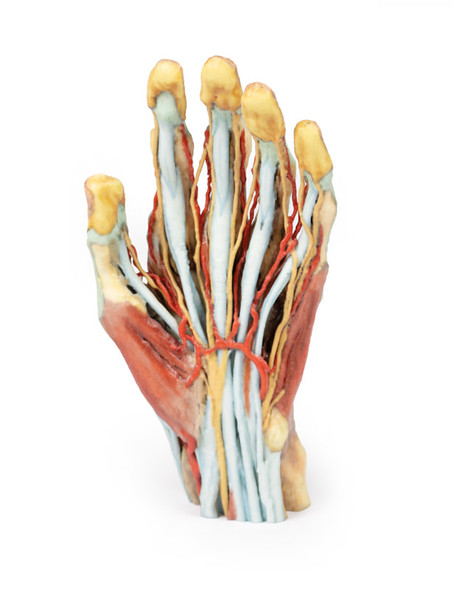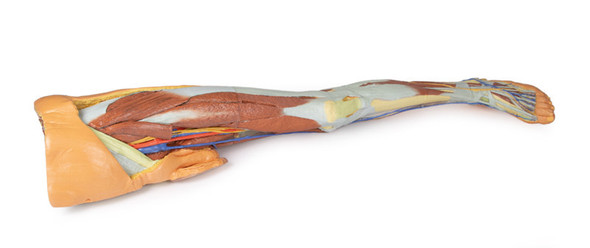Description
At the forefront of medicine and technology, we are proud to offer these incredible, uncompromised replicas of human anatomy. Using the latest 3D printing technology and materials available, this model is an exact replica of a human cadaver, brought to ""life"" by extensive medical scanning and manufacturing technologies. Over are the days of using ethically questionable cadavers, the mess of hazardous preservation chemicals, and the inaccuracies of plastinated models that often over-enhance anatomy for display, not realism. See the future, and the beauty, of real human anatomy with these incredible anatomical replicas!
This upper limb specimen displays the vascular, nervous and muscular anatomy of a left distal arm, forearm and hand.
In the distal arm and elbow/cubital fossa region we can see the arrangement of the biceps tendon, brachial artery and median nerve from lateral to medial. The bicipital aponeurosis has been divided to reveal the structures deep to it. The ulnar nerve can be seen passing behind the medial epicondyle with an ulnar collateral artery close by. The superficial branch of the radial nerve can just be seen in the space between brachioradialis and brachialis muscles (as the belly of the latter muscle has been displaced slightly laterally).
In the forearm, the superficial flexor muscles arising from the common flexor origin can be clearly seen (from lateral to medial- pronator teres, flexor carpi radialis (FCR), flexor digitorum superficialis (FDS) and flexor carpi ulnaris (FCU)). There is not a palmaris longus muscle in this cadaver. The radial artery and superficial branch of the radial nerve (emerging half way down the forearm from behind the brachioradialis muscle and tendon) are clearly identifiable. The ulnar artery can be seen in the distal forearm emerging from beneath FCU muscle.
On the posterior aspect of the forearm the extensor muscles arising from the common extensor origin are clearly identifiable. These include (from medial to lateral) the extensor carpi ulnaris (ECU), extensor digiti minimi, extensor digitorum and extensor carpi radialis brevis (ECRB). The extensor carpi radialis longus (ECRL) can be seen arising from the inferior aspect of the lateral supracondylar ridge. Further distally the abductor pollicis longus (APL) and extensor pollicis brevis (EPB) can be seen emerging from deep to superficial and 'wrapping' around the radius. They along with extensor pollicis longus (EPL) (partly hidden) travel distally to insert into the extensor or dorsal surface of the base of the 1st metacarpal, proximal phalanx and distal phalanx of the thumb, respectively. The anatomical snuffbox is displayed with the radial artery in its floor (surrounded by fat) and the cutaneous branch of the radial nerve in its roof. The extensor retinaculum is clearly visible on the dorsum of the wrist and distal to it the tendons of extensor indicis and ECRB and ECRL can be seen inserting into the 2nd and 3rd metacarpals.
In the hand, the superficial dissection reveals muscles of the thenar and hypothenar eminences, the flexor retinaculum of the hand (roof of the carpal tunnel), the long tendons of the hand, the lumbricals, and the superficial palmar arch arising from the ulnar artery, which passes into the hand lateral to the pisiform bone above the retinaculum, along with the superficial branch of the ulnar nerve. The large median nerve can be seen passing beneath the flexor retinaculum between the FCR and the FDS tendons. Digital arteries and nerves can be clearly seen further distally in the palm entering the digits. Note in particular the small recurrent branch of the median nerve crossing over the flexor pollicis brevis close to its origin from the retinaculum. The extensor expansion is dissected on the middle finger.
This model measures 22x7x3.5 when laying flat on a table. The width of the hand alone is 5 inches. From the wrist to the elbow, the arm is 10.5 inches. The circumference of the wrist is 7.5 inches. Around the top portion of the arm, the circumference is 8 inches. The length of the index finger is 3.5 inches.
Please Note: Thanks to the flexibility of manufacturing that 3D Printing offers, this model is ""printed to order"", and is not typically available for immediate shipment. Most models are printed within 15 working days and arrive within 3-5 weeks of ordering, and once an order is submitted to us, it cannot be canceled or altered. Please contact us if you have specific a specific delivery date requirement, and we will do our best to deliver the model by your target date.
Advantages of 3D Printed Anatomical Models
- 3D printed anatomical models are the most anatomically accurate examples of human anatomy because they are based on real human specimens.
- Avoid the ethical complications and complex handling, storage, and documentation requirements with 3D printed models when compared to human cadaveric specimens.
- 3D printed anatomy models are far less expensive than real human cadaveric specimens.
- Reproducibility and consistency allow for standardization of education and faster availability of models when you need them.
- Customization options are available for specific applications or educational needs. Enlargement, highlighting of specific anatomical structures, cutaway views, and more are just some of the customizations available.
Disadvantages of Human Cadavers
- Access to cadavers can be problematic and ethical complications are hard to avoid. Many countries cannot access cadavers for cultural and religious reasons.
- Human cadavers are costly to procure and require expensive storage facilities and dedicated staff to maintain them. Maintenance of the facility alone is costly.
- The cost to develop a cadaver lab or plastination technique is extremely high. Those funds could purchase hundreds of easy to handle, realistic 3D printed anatomical replicas.
- Wet specimens cannot be used in uncertified labs. Certification is expensive and time-consuming.
- Exposure to preservation fluids and chemicals is known to cause long-term health problems for lab workers and students. 3D printed anatomical replicas are safe to handle without any special equipment.
- Lack of reuse and reproducibility. If a dissection mistake is made, a new specimen has to be used and students have to start all over again.
Disadvantages of Plastinated Specimens
- Like real human cadaveric specimens, plastinated models are extremely expensive.
- Plastinated specimens still require real human samples and pose the same ethical issues as real human cadavers.
- The plastination process is extensive and takes months or longer to complete. 3D printed human anatomical models are available in a fraction of the time.
- Plastinated models, like human cadavers, are one of a kind and can only showcase one presentation of human anatomy.
Advanced 3D Printing Techniques for Superior Results
- Vibrant color offering with 10 million colors
- UV-curable inkjet printing
- High quality 3D printing that can create products that are delicate, extremely precise, and incredibly realistic
- To improve durability of fragile, thin, and delicate arteries, veins or vessels, a clear support material is printed in key areas. This makes the models robust so they can be handled by students easily.

